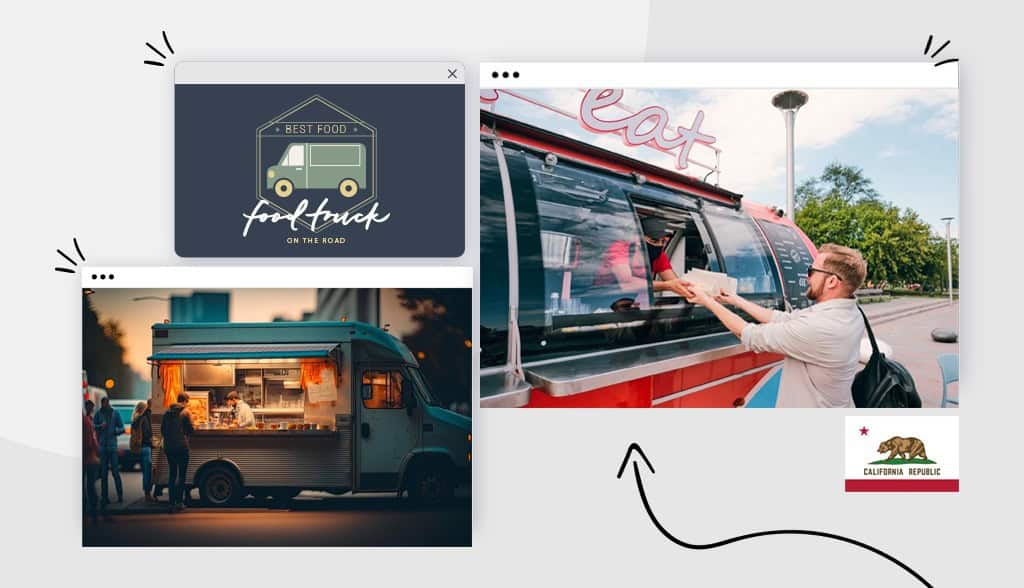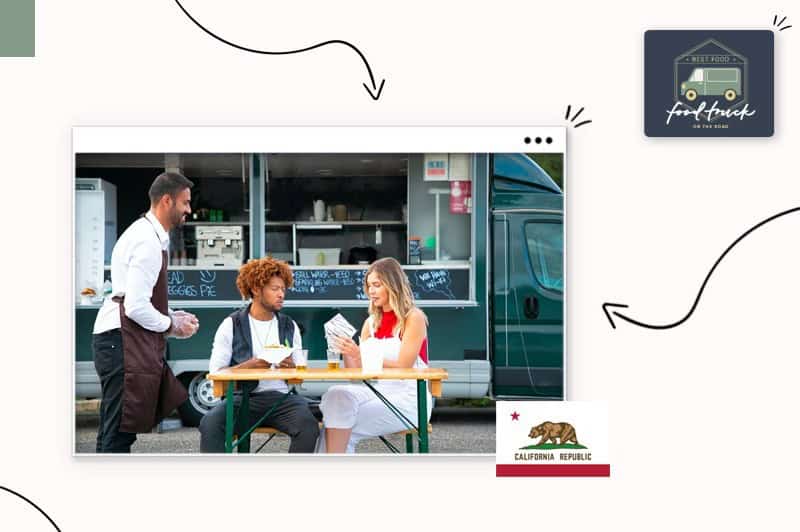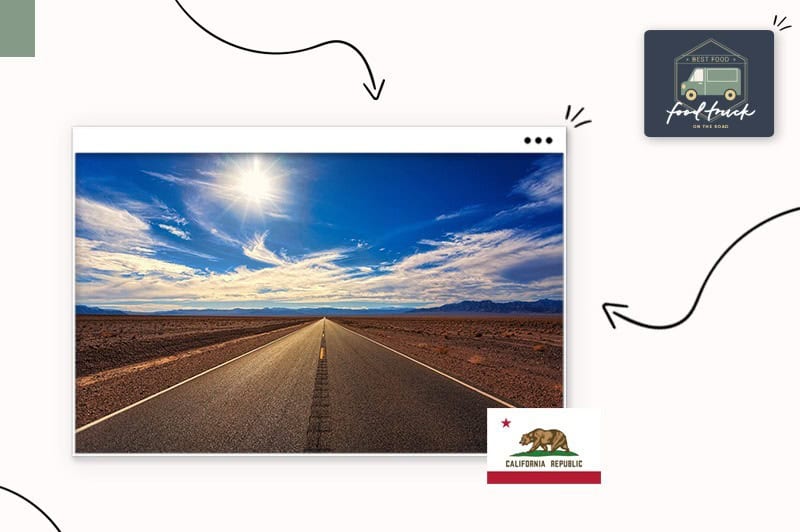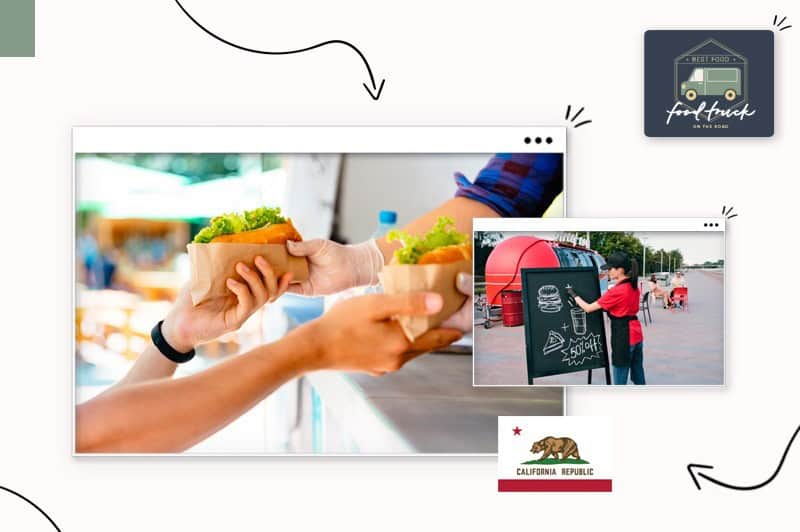
Start a Small Business → Start a Business in California → How to Start a Food Truck Business in California
Looking to turn your love of food into a dream business?
The food truck industry suits anyone with a burning desire to start their own business, offering enormous opportunities to culinary entrepreneurs with a yearly growth of 3.4% and a value of $2.2bn in 2023.
It’s a mix of lower entry costs than a brick-and-mortar restaurant and a shift in consumer food preferences (people now want unique and exciting high-quality food at an affordable price) fueling the growth.
But as with most new businesses, industry knowledge, a solid business plan, the proper business structure, and enough startup cash are crucial to your success.
Our guide will help you claim your slice of the pie or, at the very least, give you food for thought!
Are you hungry for more?
Great, here’s what you need to know about how to start a food truck business in California.

“Food trucks let creative chefs, with little money, start creating and selling their stuff. [food trucks] are always better than fast food.”-Anthony Bourdain.
Chef Bourdain was right. But let’s also answer that question with some tasty statistics.
And it’s accessible to everyone:
These are all excellent reasons to start a food truck business in California and why 36,324 are now operating in the U.S.
But potential profits aside, here are several other reasons you might start a food truck business:
Your success isn’t dependent on choosing the perfect location with a high footfall because if business is slow in one area, you can move to another.
The average U.S. leased restaurant startup cost is $275,000, rising to $425,000 if you buy the building.
That’s $3,734 per seat!
The average food truck startup cost is $55,000 to $75,000 (we’ll look at those later in the post).
While that isn’t chicken feed, it’s much cheaper and less risky than a restaurant, plus you don’t need seats!
You can do unlimited covers with no tables to turn because hungry customers order to go.
And people love that! “Food truck fans cite convenience, quality food at low prices, and short waiting and serving times as the most enjoyable aspects of this type of dining.” Mobile Cuisine.
Unbelievably, one Kogi BBQ truck did over 2000 covers in one night at $5 an average order; you do the math!
Food trucks are growing in popularity for large event organizers and smaller private affairs like weddings, as they’re cheaper than traditional catering.
Plus, people love the food truck vibe and the relaxing atmosphere, making it a recipe for success.
Pro tip:
Roaming Hunger.com recommends one food truck for every 200-300 event attendees.
With quick turnovers and geographical freedom, food truck owners can customize their menus to try new recipes and food concepts to suit demand, then use the most popular and profitable when they find them.
Off the Grid.com reports that “experimenting with new menus is a regular occurrence for 34% of mobile businesses.”
Your food truck’s a moving billboard people see everywhere it goes; paying for that continuous transit brand advertisement is often beyond the budget of most small business owners!
Food trucks are also perfect for user-generated content, as people love taking selfies beside cool-looking food trucks with a delicious meal in hand and posting them on social media, which encourages word-of-mouth marketing (WOMM), and that’s free advertising!

You now know why you should fire up the burners and start a food truck business; next, let’s look at the ingredients you need to make it a delicious success.
Food trucks are an excellent way to bring your culinary ideas to the world, but first, you must choose your concept (the cuisine you’ll serve), which plays an essential role in your success.
Three ingredients make a winning food truck concept:
When you nail an in-demand concept, it’s much easier to establish your brand and attract a hungry audience. And you don’t need to reinvent the culinary wheel to develop an in-demand food truck menu, as many proven options exist.
Here are some to get your taste buds tingling:
Remember, think hard before choosing your concept because you’ll live it 24/7 for the foreseeable future.
Most business success comes from market awareness because when you know who you’re selling to, you can design your marketing strategies and branding around them.
Here are 2 statistics worth considering when determining your food truck target market:
Before you invest in the food truck business, learn about your customer’s demographics, including their location, how often they visit food trucks, their payment methods, and how they’ll search for your business.
And run local surveys and visit other food trucks in your area to discover how to design a service that gets customers eating out of your hands.
Starting a food truck business takes market research, planning, and often funding, and that’s where a business plan can help you.
Business plans come in 2 forms: single-page and traditional. You’ll need the latter if you require funding, as it contains a comprehensive financial forecast detailing your break-even analysis and shows how you’ll repay your investors.
Funding aside, writing a business plan validates your idea using proven research strategies that outline the steps you must take to start a successful food truck business.
Starting a food truck business can cost between $40,000 and $250,000, depending on your truck, cooking equipment, and location.
Startup costs include fixed and variable. Fixed are costs that never change regardless of how many meals you sell, while variables are relative to your sales volume.
Other startup costs include permits and licenses, a point of sale (POS) system, and legal consultations. And factor in ongoing expenses like marketing, insurance, and payroll costs.
Pro tip:
For your first 3 years, don’t spend money on anything you don’t need to run your food truck.
Once you know your startup costs, you can determine whether you need funding and how much.
Funding sources:
Besides traditional bank loans and business credit cards, you’ve many ways to fund your food truck adventure.
Such as:
California food truck licenses and permit requirements can vary between counties (and cities), as do the names, so check with your local health department or Board of Health regulations to determine which ones you’ll need to operate.
That said, most counties require (at minimum) a commercial business license and food service permit to start a food truck in California.
General commercial licenses:
Food service permits:
Pro-tip:
California food safety regulations exist to protect people’s health, so they’re challenging, and one negative inspection can hurt your business.
To avoid disappointment, companies like ServSafe offer courses, testing, and support to help you comply with California’s food permit laws.
Your food truck’s success depends on reaching people where they’re at or fitting several dining options into a high-traffic small area, like a food truck park.
The key to choosing profitable locations relies on your target audience research and how efficiently you plan your route.
You have 3 choices when choosing your location:
Regardless of how you roll, you must base your locations on a needs analysis (who wants your service) to ensure they suit your food truck’s concept and your target audience’s demographic.
For example, are your customers in busy commercial or residential areas not well-served by restaurants? Or does your menu suit a lunchtime office crowd or the post-bar night owls?
Pro-tip:
Choosing a permanent location may sound counterintuitive to the idea of a mobile food truck!
However, a consistent location can make it easy for your target audience to find you, and you can corner an area where you’re servicing.
Talk to local business owners with big parking lots to discuss how adding your food truck can be a symbiotic relationship. Plus, the parking rent might be cheaper than the gas you’d use driving!

Keep your menu simple, infuse it with a gimmick, and price it at its worth.
Wise advice from a food truck owner friend of mine.
Sure, your food truck concept determines your core menu, but adding culinary flair to the mix, such as imaginative variations, homemade sauces, and innovative recipes (like Asian-infused tacos), is how you’ll create a memorable food truck brand.
When creating your menu, ensure you can consistently make each dish in large quantities, that they travel well, and are easy to serve and eat.
Pricing pro-tip:
Average food truck profits are 10-15% of gross, but if you price too cheaply, you could run out of gas!
Figure out your fixed and variable costs and profit margins, and price your items at 20-25% over your food cost, no matter the end price.
Because your target audience isn’t those who say your correctly priced food is too expensive. Your ideal clients are those customers who want to pay what something should cost from a quality food truck business.
Because of your business’s mobility and expensive equipment, choosing the right food truck insurance policy can be tricky. But as your livelihood depends on adequate coverage, insurance isn’t something you can leave on the back burner.
Your insurance requirements depend on many factors, like whether you tow a food truck trailer or have employees.
Five insurance policies you might need are:
The more payment options you offer your customers, the better for your business because, besides cash, people like using credit/debit cards and mobile payments when buying their tacos, dogs, or smoothies.
You can guarantee every sale using a Point Of Sale payment gateway solution with built-in processing like Square.
POS systems provide software that facilitates the many operational aspects of a food truck business by acting as a central dashboard, enabling you to take payments, track inventory, and manage orders.
Your truck is your most significant investment, and costs can vary from $20,000 to $150,000, depending on what you need and how you buy it.
The average cost of getting a food truck and all the permits ranges between $50,000 and $60,000 (Food Truck Nation).
You can get a food truck in 5 ways:
Regardless of your route, your truck must be up to code and have industry-standard equipment, cold and dry storage units, and adequate water pressure.
Pro-tip:
Found an exciting food truck that doesn’t have a C.A. permit?
Contact the California Department of Public Health and pay them to assess it and tell you what you need to pass their inspections and get the necessary permits.
Sure, it costs a few bucks, but it might be the best money you’ll ever spend.
Your chosen concept should play an essential role in your design.
For example, a coffee truck could be small and only require electricity, a coffee machine, a fridge, running water, and sinks. In contrast, a taco truck would be more extensive and need gas lines, ovens, and grills.
To whet your appetite, look at food truck designs on Pinterest and find inspiration on food truck manufacturer websites.
You’ll also need to create a website that reflects your brand’s style. You can build it using an online tool or outsource it to a professional web developer on a freelance platform like Fiverr, freelancer, or Upwork.
A simple website with your menu, locations, contact details, and customer testimonials should do the job.
The Kogi website is a perfect example:

Your new business also needs an eye-catching logo that tells your target audience what you serve and resonates with their foodie emotions.
The famous “Kogi BBQ taco” and the wonderfully colored “Curry Up Now” Indian food trucks are 2 prime examples.
Both are unique, and that’s why they work so well; they’re as bespoke as the food truck cuisine and their brand’s personality.
Your food truck branding is an excellent opportunity to advertise your business and engage with your community.
Many approaches are available for food truck branding, such as entire truck wraps, graffiti-style techniques, and more reserved and elegant designs.
A full truck wrap:

Choose a style, colors, and visuals that fit your brand’s personality, target audience, and menu, then use it on all your marketing materials to create brand awareness.
Social media is an essential advertising strategy when you start a food truck business in California.
Successful food truck owners know this and use social media to their advantage by creating a buzz about their brand and a loyal foodie community that helps promote their business for free.
For example, you can use Instagram to showcase your menu and share promotions with your customers:

And use Twitter to stay in touch and inform your hungry audience by providing dates and times of where you’ll be serving that day.
Owner of 4 popular Kogi trucks L.A. Koreatown native chef Choi uses Twitter to announce their arrival throughout the city, where enormous crowds eagerly await.

All businesses benefit from encouraging positive user-generated content. UGC is when the public becomes part of your marketing strategy, such as taking selfies with your truck and recommending it to friends.
When you encourage your customers to spread the word about your business using images, videos, and glowing testimonials, you’ll have them queuing up around the block.

And use food porn (tantalizingly tasty pictures of your food) to encourage customers to share images of your menu; it’s great for driving business.

Food delivery apps are hugely popular, and food truck operators can use them to increase their business.
These apps allow customers to place takeout orders from the comfort of their homes; the app company then does the rest.
Some advantages of food delivery apps include reducing your customer line and shortening wait times. Staff can prioritize food orders. And they reduce traffic congestion around your truck.
Use apps like Uber Eats, GrubHub, Postmates, and DoorDash to add a food delivery service to your food truck business.
All that remains is to create a food truck advertising campaign to let people know you’re open for business.
Social media platforms, your website, and your truck branding can all help with advertising. Still, some traditional marketing strategies can drive customers to your truck.
Pro-tip:
Food trucks have limited space, and you might need to prep food elsewhere, but it’s illegal to prep in a private home!
Fortunately, commissaries provide food truck owners with access to commercial kitchens to prep and store their food.
Commissaries can save you hassle and money as they have industrial ovens, cold and dry storage areas, and other commercial kitchen equipment that comply with city and state food codes.
Many commissaries also provide overnight parking, electrical charging points, food waste disposal areas, and wash bay facilities.
Depending on the commissary’s services and location, costs range from $500 to $1,500 per truck.
You need a permit from your county’s health department to operate a Californian home-based food business.
Based on industry data, an efficient food truck can earn $23,000 to over $100,000 annually, depending on location, menu, and marketing strategies.
Food facility health permits and licensing requirements vary from county to county, so costs vary.
For example:
Starting a food truck in California involves more than just getting the proper business permits and licenses; those are easy.
Your menu, willingness to grind every day (especially in the summer when it’s 100° +), and how you market your truck matter most.
And don’t let anyone sway you from doing what you want; it’s YOUR BABY!
As chef Jose Andres once said:
“Life begins on the edge of the unknown; that’s where we learn the most.”
This portion of our website is for informational or educational purposes only. Tailor Brands is not a law firm, and the information on this website does not constitute legal advice. All statements, opinions, recommendations, and conclusions are solely the expression of the author and provided on an as-is basis. Accordingly, Tailor Brands is not responsible for the information and/or its accuracy or completeness. It also does not indicate any affiliation between Tailor Brands and any other brands, services or logos on this page.
Products
Resources
©2025 Copyright Tailor Brands